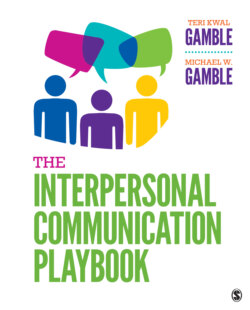Читать книгу The Interpersonal Communication Playbook - Teri Kwal Gamble - Страница 130
На сайте Литреса книга снята с продажи.
Fact-Inference Confusions
ОглавлениеA fact is something we know is true on the basis of observation. Unlike opinions or inferences, facts are not disputable. An inference is a conclusion we draw, whether or not it is supported by facts. If you assume your neighbor is having an affair based solely on the fact that an unfamiliar car comes to her house every few days for an hour or so, you are making an inference.
When we mistake what we infer for something we have observed, we experience fact-inference confusion. Inferences have varying degrees of probability of being correct; their validity depends on the facts that underlie them. For instance, “The sun will rise tomorrow” is not technically a statement of fact; it is an inference with a very high probability of being correct. In contrast, if you see a friend talking and laughing with another person, and you conclude that the two of them are hooking up, that would be an inference with average to low probability of being correct.
Inferences can have serious consequences for our relationships. They can cause us to jump to erroneous conclusions, create embarrassing moments, and result in our responding inappropriately to others. Thus, we need to take time to evaluate whether we are relying on facts or on inferences when we perceive and interpret another’s behavior. The question is not whether we make inferences but whether we are aware of the inferences we make. If we are aware that we are inferring and not observing, and we can accurately assess the probability that our inferences are correct, we take a giant step forward in improving our perceptions.
Try This: Can You Tell the Difference?
To test your understanding of facts and inferences, read the following brief story and the statements that follow it. If you think a statement is true, circle T; if you think it is false, circle F. For an inference that might be either true or false, circle the question mark. (Answers appear below at the bottom of this box.)
You arrive at school one day and see that a number of police cars and an ambulance are parked at the front gate of the campus. Also parked there is a car with “Dr. Smythe” on the license plate.
1 Police cars are parked at the front gate of the campus. T F ?
2 Someone at the college has been shot. T F ?
3 The police summoned the ambulance. T F ?
4 The car with “Dr. Smythe” on its license plate is not parked at the front gate. T F ?
5 The man who owns the car is Dr. Smythe. T F ?
Fiction and drama frequently revolve around fact-inference confusion. Think of a TV show, film, or novel plot that is held together by fact-inference confusion. Analyze what occurs in the story and describe what the involved characters could have done or said to avoid it.
Answers: 1. T; 2. ?; 3. ?; 4. F; 5. ?
There are other problems with facts. Sometimes indisputable facts are not accepted. In 2016, the Oxford Dictionary declared the word post-truth its word of the year. Relentlessly repeating false claims somehow helps them stick. Because some people are increasingly willing to dispute facts—labeling them as fake news—fact-checking has grown into its own industry with the goal of identifying lies or errors.43
